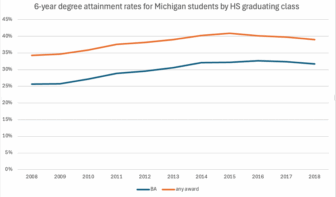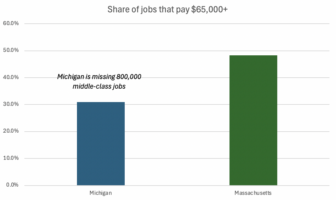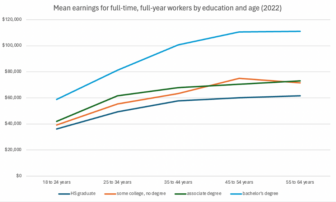Every time the state gets into financial difficulty there are calls for some kind of centralization of the state’s higher education system. Led by the business community and editorial writers. It’s a bad idea! Hard to figure out since both groups argue that markets are better than centralization of both the private sector and k-12 education. If centralization doesn’t work in those sectors why would it work better in higher education?
Grand Valley President Thomas Haas does a terrific job in a recent Dome article making the case that more state control of higher ed is a bad idea. So if centralization is not the answer what is?
We laid out in our A New Agenda for a New Michigan report a fundamentally different and we believe far better approach – one that is market based – to insuring a quality higher education system in Michigan. We wrote it in 2006. Four years later it’s an agenda that we need more than ever! Here is what we recommended (slightly edited):
As we assess the assets Michigan has to prepare, retain and attract talent, our higher education system rises to the top of the list. Michigan has spent decades building a world class systems of higher education – both universities and community colleges. They are arguably the most important assets we have in developing the concentration of talent we need to be successful in a knowledge-based economy. That is particularly true of our major research universities.
Higher education’s importance in preparing talent for a knowledge economy is clear. But it also is one of – if not the – most important assets in retaining and attracting talent. Our universities – particularly the research universities – are among the few enterprises in the state that attract talent from around the world: students, faculty and researchers.
So the single most important thing policy makers can do for the future economic success of Michigan and its regions is to ensure the long-term success of a vibrant and agile higher education system.
Unfortunately, after decades of building a world class higher education system, Michigan has been under investing in our universities and community colleges for years. Over the past decade, state funding for higher education has been consistently cut. Policy makers have consistently ranked higher education as a lower priority than tax cuts, k-12 education, prisons and health care.
To make matters worse, policy makers have combined funding cuts with jaw boning to get public higher education institutions to limit tuition increases. Thus restricting the two main sources of revenue needed to insure their continued quality. Despite a state constitutional guarantee of autonomy, there also has been an uptick in policy makers interest in micro-managing public higher education institutions. A variety of state policy makers have tried to influence admission policies, curriculum, facilities funding, personnel policies, etc.
All of this threatens the quality of arguably Michigan’s most important economic asset in a knowledge economy. What we need from policy – and are not getting – is a commitment to insure a system of higher education that is world class in (1) preparing students for success in a flat world and (2) contributing to new knowledge creation.
We need a new approach to state support for higher education. One that will give us a better chance of maintaining a high quality and agile system of higher education for decades to come. We propose a new structure for state support of higher education. It would have three components:
1. Institutional independence at public universities and community colleges.
Each of our public community colleges and universities has a public governing body to represent the best interests of citizens. Beyond that, in a highly competitive industry, markets and competition are the best way to set prices and to insure long-term quality. This means, most importantly, giving public higher education institutions autonomy over (1) setting tuition (2) recruiting students from anywhere on the planet (3)programs, curriculum and pedagogy and (4) facilities
2. Provide state funding to students, no matter from where they come, rather than to institutions.
With autonomy, institutions will control their revenue based on their ability to compete in the marketplace. The state’s role should be to make higher education more affordable to students. We believe this is a terrific – probably the best – investment for the future economic success of the state. So, the higher proportion of tuition paid by the state, we believe the better for the state’s future. The reality is, given the state’s chronic structural deficit, there is almost no chance of a substantial increase in higher education funding without a tax increase. We recommend a single fund that would take the place of all state funding for higher education (including merit scholarships and capital outlays) and would provide students with a voucher/ foundation grant.
3. Provide a substantial state match for federal research funding.
Create a second, smaller but still substantial, pool of funds that would provide a match (goal of 20%) for federal research funds. Universities could use funds either to provide match to win grants or to invest in additional research or research facilities. Matching funds should be awarded to nonprofit research institutions that win federal research grants as well.
Research universities may be the most important assets Michigan has in creating a vibrant knowledge-driven economy. We can’t emphasize enough, in a knowledge economy, the strategic importance of our major research universities. Communities across the globe, recognizing the importance of research universities, are trying to replicate what we already have here. One can make a strong case that the most productive state and local economic growth policies over the past several decades have been public investments in research universities in Austin, San Diego and North Carolina’s Research Triangle. The payoff in each case has been huge.
For some reason, even though we have one of the great research universities in the world and two others that rank in the top 100 nationally, Michigan policy makers have never viewed major research universities as a key economic resource. This needs to change! These universities are, in and of themselves (even if there are no spin off jobs), major export-based enterprises. In total Michigan universities bring in more that $1 billion annually of federal funds and employ thousands of knowledge workers. In addition, they are major retainers and attractors of talent from around the world. And, although there are no guarantees, places where new knowledge is being created have a big edge in being the places where new technologies are commercialized.







